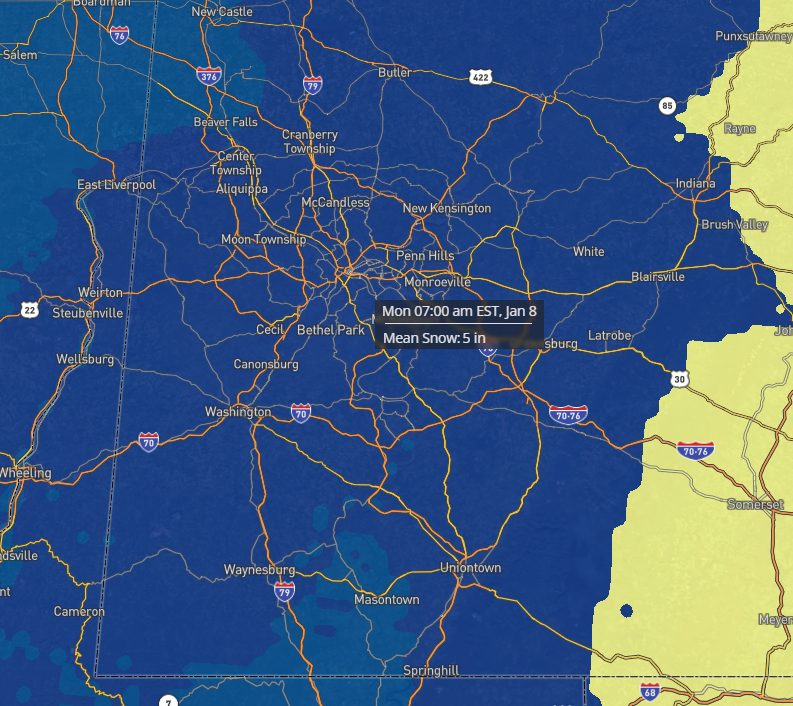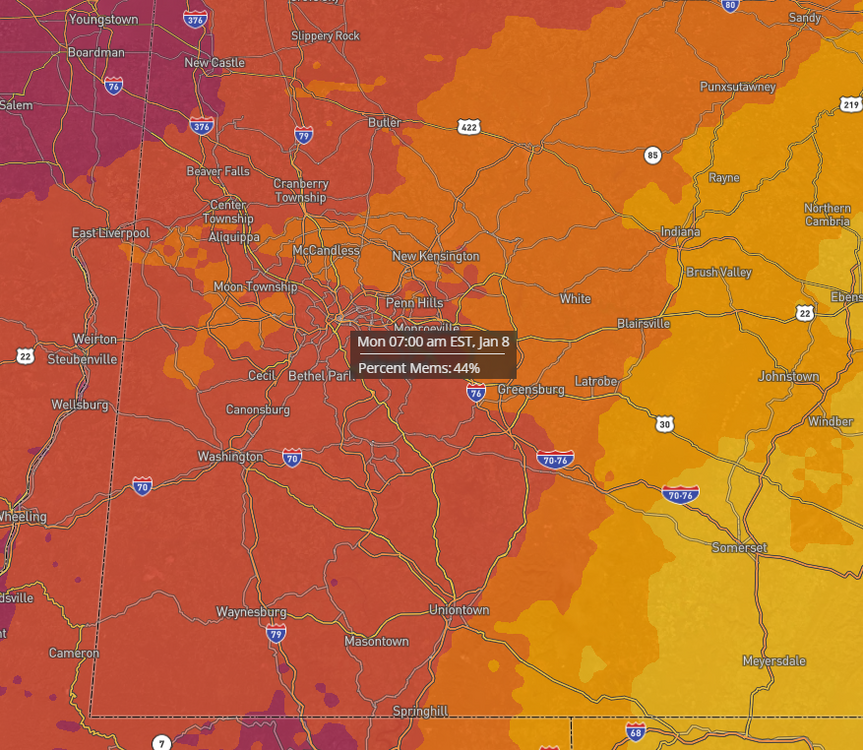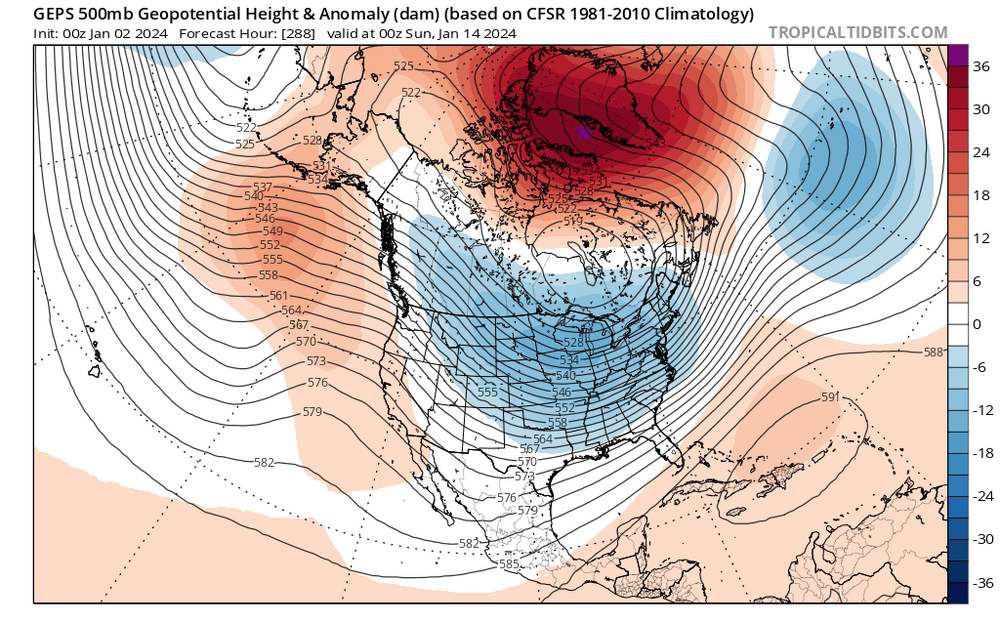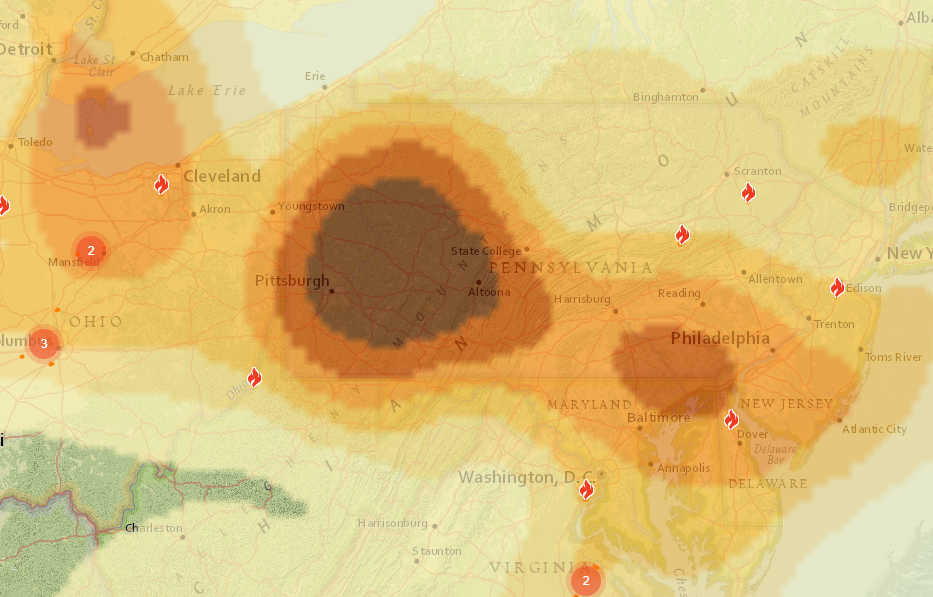-
Posts
1,251 -
Joined
-
Last visited
Content Type
Profiles
Blogs
Forums
American Weather
Media Demo
Store
Gallery
Everything posted by jwilson
-

Pittsburgh, Pa Winter 2023-24 Thread.
jwilson replied to meatwad's topic in Upstate New York/Pennsylvania
Next I wanted to look at the charts. Let's start with the 0Z from earlier. Here we can see the primary differences. Notice the flatter flow to the north of our system which acts as a quasi-block. It both prevents the storm from gaining too much latitude and slows it down a little bit. The combination results in a stronger shortwave. You also have that piece of energy along the west coast digging a bit deeper which opens the entire CONUS-wide trough. This is harder to picture at the surface, but here we see the flatter flow once again and how that energy up north was elongated and less phased. The flow is mirrored on the H500 above. The energy in the central U.S. is also less concentrated, at least partially because of the west and east coast systems separately. But then we get into the 12Z models. Here we see that west coast energy is a little less pronounced, and instead the energy over Texas is digging dramatically southward. This creates a more zonal look to the flow out ahead of it. It's less into a trough on the east coast and more straight-line. We also see heights rising up north, mostly because that energy that was spread out or elongated before is now more concentrated to the East. Here we can see that northern piece a bit better. Notice again that at 0Z it was flat and stretched. Now it's a consolidated blob pushed slightly to the East. This is helping to pump those heights out ahead of the east coast shortwave, which both pulls it a little north and also opens the flow out ahead so it can escape more freely. Instead of our storm getting trapped underneath, it is now free to slide off the coast and rotate north around the rest of the waves. These are the key pieces of energy to watch going forward. We don't have a true block so it could really go either way. But if that energy up north phases too soon, we get conditions that allow our storm to progress along the boundary instead of getting dug in. The energy behind it also isn't helping, though these pieces are all acting in concert. We might still get a nice 3-6" event, but the ceiling is much lower than if we had more optimal interactions. -

Pittsburgh, Pa Winter 2023-24 Thread.
jwilson replied to meatwad's topic in Upstate New York/Pennsylvania
Same NBM, and considering the blend, the average snow across all models is 5" (must be skewed upward by a few big hits). -

Pittsburgh, Pa Winter 2023-24 Thread.
jwilson replied to meatwad's topic in Upstate New York/Pennsylvania
Here's the 13Z NBM (National Blend of Models). I set the threshold at 4", so right now this predicts our odds of >4" at 44%. -

Pittsburgh, Pa Winter 2023-24 Thread.
jwilson replied to meatwad's topic in Upstate New York/Pennsylvania
Bear with me, all. I'm going to make a few posts here. Haven't done this in a while so I'd like to get those snow juices flowing again. Yep. We notice a sort of "see saw" action with the energy over Oklahoma / Texas. As it digs southward, it pumps the flow ahead of it and bumps our shortwave northward. The other problem, which I'll illustrate below, is the open confluence to the north. The 12Z Euro shows this almost zonal look to the flow, but it's north enough we get better snow than at 6Z. -

Pittsburgh, Pa Winter 2023-24 Thread.
jwilson replied to meatwad's topic in Upstate New York/Pennsylvania
Since I'm here, I'm watching the 12Z GFS roll out. Looks pretty similar to 6Z thus far. Primary is pushing into southern West Virginia which is starting to get a little close for the mix concerns. The timing of this transfer is relevant. One of the big differences between the 12Z and previous runs is the energy in the Central US is digging further south and we're getting more northern stream interaction (CMC and GFS). This is a fast-moving system so we won't have time to set up for something really big, but the dynamics will determine how potent a bomb we get for 8-12 hours. It's good they are both there, because the 6Z Euro trended away from this sort of environmental interaction. Question is whether Euro follows. -

Pittsburgh, Pa Winter 2023-24 Thread.
jwilson replied to meatwad's topic in Upstate New York/Pennsylvania
To be honest, I almost want to look beyond this event and notice both the Euro and GFS setting up a rather significant -NAO block the following weekend. The ensembles and operationals all have it. Traditionally, when you would weaken a block of this magnitude is when you hunt for the KU, but it's presence looks likely to deliver us the first chance of real cold this winter. Anything that happens underneath is worth watching. It's been a while since we've had this setup. -

Pittsburgh, Pa Winter 2023-24 Thread.
jwilson replied to meatwad's topic in Upstate New York/Pennsylvania
Half of the 30 GEFS members show a 6"+ storm for Pittsburgh metro or are very close to it. Perhaps 10 certain and then a few that are inexact given the resolution. That's not quite what I'd consider "honking," but it's still quite good at this range. A handful more show a fringe event (borderline minor to moderate or a fringe special). Five show what's basically a non-event. -

Pittsburgh, Pa Winter 2023-24 Thread.
jwilson replied to meatwad's topic in Upstate New York/Pennsylvania
There's a signal for something this weekend, which is about the best we've done in quite a while. Plus with the weekend rule in effect, that's an additional +25% to confidence scores. I do prefer this one south to start - at longer leads, that is. We know that they generally bump north gradually as the T-0 clock closes. If the starting point is us getting bullseye'd, mixed, or some kind of southern fringe solution, chances are much higher we'd lose it altogether. If we're still on the northern fringe at say 48 hours, then you start to get worried about suppression. -

Pittsburgh, Pa Winter 2023-24 Thread.
jwilson replied to meatwad's topic in Upstate New York/Pennsylvania
It is getting more difficult to extrapolate based on past data, although last year (considering previous 3-season Ninas) I didn't expect much and that turned out prescient. We hit our lowest snowfall total since the winter of 1990-91. This year I'm torn. Super Ninos can definitely be too much of a good thing, as you've already pointed out. We also don't get the same ocean influences as the coast, so while they may require certain conditions, what's good for them may wreak havoc on our own snow chances. The odds of beating last year are quite high, however. Almost automatic. We haven't had back-to-back sub 20" snowfall winters since the early 30s. Doesn't mean we'll be above average, of course. Maybe that also means we're due. I will say, almost every time we've hit +2.0 on the Nino scale, we've had <30" that winter ('82-83 was 30.1" so close enough). Not sure if we'll get to that deviation but it does look close. If so, your safe bet might be on a sub 30" winter. -

Pittsburgh, Pa Winter 2023-24 Thread.
jwilson replied to meatwad's topic in Upstate New York/Pennsylvania
Thunder and lightning here. Now it feels like Christmas! -
Little hope for Flyers or Sixers, so it's all up to the Eagles now. I do think the Phillies could have won that series were it not for a mismanaged Game 4, although two years in a row of dead bats is concerning.
-

Pittsburgh/Western PA Fall 2023 Discussion
jwilson replied to Ahoff's topic in Upstate New York/Pennsylvania
To be honest, I don't expect any real snow until January or February. Maybe we get lucky with some small stuff, but through December figures to be warmer than average. Typical El Nino stuff. -
A little disappointed we couldn't eke out a basic thunderstorm. We haven't had that many this year (at least in the South Hills).
-
I think that's probably likely as our climate moves towards a facsimile of Atlanta. Pittsburgh is a bit too far from the lakes to get the "real" influence and too far from the coast to benefit from all the coastal bombs that are forming nowadays with warming waters. Hence why the coastal sections all run in the positive deviations. It's also not at a high enough elevation to generate the kinds of mountain snows we'd see in the ranges. We tend to nickel-and-dime our way to 40" as it is, and I would imagine tiny shifts in climate can make some of those little events become less common or more likely to be rain showers.
-
The long-term pattern still not showing much sign of abating. The west dries up, and while we aren't quite as dramatically under a trough the whole time, we're still wet-looking for almost the entire period. Really everywhere from the plains on east. 2-3" over the next week.
-
The trough-in-the-East pattern still holds in the long-term. It doesn't look supremely wet, though, so it's kind of a mixed bag (only 2" of rain through the end of the month). The only real ridging in the conus is pretty narrowly focused over the central plains. This pattern will limit the heat potential, which I guess most people prefer. How much rain we end with is the question and if things change come July.
-
Looks like that's the pattern for the foreseeable future. Hudson Bay highs with everything rotating underneath and cutoff. Probably 3-4 weeks at least. I'm guessing by the end we'll have made up for most (if not all) of the deficit.
-
Next week looks like a repeat of this week with the low further south. Kind of a depressing pattern if that holds up. Figured we'd pay for that nice stretch of weather at some point.
-
Friday could be another bad smoke day. Courtesy FireSmoke.ca - this is Friday morning say between 8 AM and Noon. We'll see if it holds.
-

Pittsburgh/Western PA Spring 2023 Discussion
jwilson replied to Ahoff's topic in Upstate New York/Pennsylvania
When is the last time PIT hit 100F? I think the last time I can remember temps that high out here was like 2012 or 2013. I lived in Morgantown back then and we did manage to go over 100F. But I think that's it. Seems pretty rare for PIT to go up there. I feel like we haven't even had that many serious heat waves over the last decade. Perhaps I'm used to worse summers coming from Philly. -

Pittsburgh/Western PA Spring 2023 Discussion
jwilson replied to Ahoff's topic in Upstate New York/Pennsylvania
GFS looks bad for the first week of May. 30s and 40s (as highs). We'll see if it holds, but that's not a terribly great start to pre-summer. I knew we'd pay for those early 80s, though. Snow flurries the last two days. -

Pittsburgh/Western PA Banter & Complaint Thread
jwilson replied to blackngoldrules's topic in Upstate New York/Pennsylvania
For me it's just over this particular season. The winter was dull; we only got to track maybe two total events. Most were 10-day storms that disappeared after a couple model runs. There wasn't much to get excited about. Now I'd rather get some good golfing weather for the spring before the heat really sets in, rather than a continuation of fake winter. It's nuisance cold, for the most part. I'd prefer some temps between cold and hot, say 60s and low 70s with minimal humidity. Spring and Fall used to be good for that, haha. -

Pittsburgh/Western PA Spring 2023 Discussion
jwilson replied to Ahoff's topic in Upstate New York/Pennsylvania
Sadly looks like we're mired in fake winter for a little while longer where we keep getting shots of cold air. Perhaps a good year to bet on some April snow. Crap.







